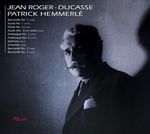|
Back
07/07/2020
“French Music Rarities – Volume 1”
Jean Roger-Ducasse: Barcarolle n° 1 in D-Flat major – Etude n° 1 in G-Sharp minor –
Etude n° 2 in A-Flat major – Etude en sixtes, n° 3 in G-Flat major – Arabesque n° 1 in F-Sharp major – Arabesque n° 2 in C major – Rythmes – Sonorités – Barcarolle n° 2 in G-Flat major – Barcarolle n° 3 in F major
Patrick Hemmerlé (piano)
Recording: Eglise évangélique Saint-Marcel, Paris, France (March and September 2018) – 66’04
Melism MLS-CD-013 (Distributed by Naxos of America) – Booklet in English and French

   
The curiosity factor has struck Patrick Hemmerlé! Grounded by a classical repertoire, this brilliant young Frenchman has ventured well out of his comfort zone in search of other composers’ imposing challenges. Littered by pitfalls and backdrops, Roger-Ducasse’s music is exceedingly difficult to play, yet the informative booklet (written by the artist himself) allows us to peek into the pianist’s personal journey. Inasmuch as Jean Roger-Ducasse’s write-up is categorized by genre, the listen by ordered text splendidly reveals the developmental form. It is from this perspective that the critique is managed.
Looking at the CD’s Photo Bordeaux of 1953 reveals a man skirted in ambiguity, ambivalence and cynicism. Jean Roger-Ducasse wanted to pen “impossible music”, in a way to shield him from the masses and give himself an occasional “pat on the back” with a sneer. He was not without his admirers, yet he also was an isolationist. A close friend to Claude Debussy, his music regales in such style, though the compositions have more “wild reaches” and undetermined boundaries. M. Hemmerlé is undaunted by such complexities, and in reality, the interpretation comes across masterfully.
Patrick Hemmerlé is a visionary...the opening Barcarolle n° 1 shows the composer’s softer side. After all, this was one of his earlier works and when Roger-Ducasse had less of a “shell” surrounding him. Thus, the piece touches upon extroversion with empathetic sincerity...wholesome. The Barcarolle n° 2’s musical penumbra is extremely complex, full of quixotic, quirky devices….approachable, yet the music “throws up a wall” in declamatory hesitancy. M. Hemmerlé gives Roger-Ducasse’s piece a thorough read-through…embracing and tumultuous with bumps and scrapes along the way…it’s a lovely composition. Yet the ensuing Barcarolle n° 3 drifts out into the open sea, reluctant to land firmly upon the listener’s ear. Patrick Hemmerlé maneuvers through its testy ridges, riddled by chaotic declamations. Though not an “easy listen”, the music is consuming.
Quoting Patrick Hemmerlé at this point is pivotal: “Since the perfect realization of his musical intention here is often not practically achievable, the goal of the interpreter is to approach as near as possible, compromising where he sees fit, without putting in jeopardy the musical integrity of the works.” Patrick Hemmerlé’s right hand never stops the incessant runs flowing upon the keys inside the densely-written Etude n° 1, hinting at Fauré (and a distant Grieg). The arduous, flowing double notes inside the Etude n° 2 gives the piece magnificent energy as if to evoke powdery flakes upon a winter evening: it’s a perpetual conundrum. Etude n° 3 begins in a bluesy Bernstein-esque avenue with abrupt, abstract distances. It first appears as if the etude is possessed by elusiveness, but the pianist fittingly relishes the ability to reconcile conflicts upon the coda build. The writing magnetizes well into Debussy. Extraordinary.
Though not in an absolute parallel persuasion to that of Debussy’s Arabesques, they’re striking familiarities. During the Arabesque n° 1 Patrick Hemmerlé’s reading of Roger-Ducasse’s constructions are astoundingly enigmatic, perched upon branches of hopefulness. The pianist also inserts a strong pregnant pause (5’16) to give a more dramatic conclusion. Arabesque n° 2, however, is more diaphanous and playful, in a Fauré-like gauze. Here, Patrick Hemmerlé highlights the score with more relaxation and frivolity.
When performing Rythmes, Patrick Hemmerlé notes, “...I have decided to play it in irregular rhythm...” The passage is almost a shuddered heart murmur...inconclusive and a puzzlement. Nonetheless, this approach gives a nod to stupendous colouring. Most effective. The contrastingly distant cousin, Sonorités, has its own dynamic storyline. M. Hemmerlé is infatuated with this music, and rightfully so. The music tugs at La Soirée dans Grenade, like an impetuous whirling dervish ablaze in habanera-like rhythms. The middle section is whimsical with a twist of sarcasm.
Few recordings of Jean Roger-Ducasse’s music are available, so now we have another addition for the library. Patrick Hemmerlé has opened our eyes to this music. The way in which he has approached this music is achieved by great insight and acuity. Superb!
Patrick Hemmerlé Website
Christie Grimstad
|